Orpheus Hellenic Folklore Society Newsletter
Festival of Greek Music and Dance 2002
| Journey
Through the Greek Isles: 2002 Festival of Greek Music and Dance |
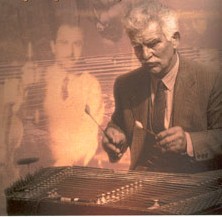 The date for the Festival of Greek music and Dance is fast approaching! On Saturday,
March 16, 2002, ten distinguished folk musicians from Greece will present music and songs
from the Greek Islands. The rhythms of the violin, tsabouna (island bagpipe), santouri
(dulcimer), oud, lute and an array of percussion instruments will fill the auditorium at
Niles West High School, 5701 Oakton St., in Skokie. The concert will begin at 7:00 p.m.
The Orpheus Dance Troupe will perform folk dances from the Greek Islands accompanied by
the visiting musicians. Tickets are available by calling 847-729-3406. The date for the Festival of Greek music and Dance is fast approaching! On Saturday,
March 16, 2002, ten distinguished folk musicians from Greece will present music and songs
from the Greek Islands. The rhythms of the violin, tsabouna (island bagpipe), santouri
(dulcimer), oud, lute and an array of percussion instruments will fill the auditorium at
Niles West High School, 5701 Oakton St., in Skokie. The concert will begin at 7:00 p.m.
The Orpheus Dance Troupe will perform folk dances from the Greek Islands accompanied by
the visiting musicians. Tickets are available by calling 847-729-3406. This is the second year that the Orpheus Hellenic Folklore Society is undertaking the organization of the Festival of Greek Music and Dance in cooperation with SAE of America. Last year's sold out concert featured artists from Macedonia and Thrace, Greece's northern regions.
This type of event provides audiences in the Midwest the opportunity to experience a live presentation of Greek folk traditions that are rarely given outside of Greece's borders. It also offers the instructors and members of the Orpheus Dance Troupe the chance to enrich their knowledge of Greek folk dances. The exchange and sharing of knowledge pertaining to this aspect of our Hellenic heritage with such accomplished artists energizes and motivates all OHFS members, who have been working tirelessly during the last several months towards the organization of this concert. We hope to see you there to enjoy the lively island melodies as well as to support the efforts and mission of the Orpheus Hellenic Folklore Society. |
| Music
Traditions from the Northern Aegean Islands |
| The islands of the Northern Aegean have played an important role in Greece's history
and culture. They have been known since antiquity for their special products, such as
olive oil, ouzo and anchovies from Myteline (Lesvos), mastic-gum from Chios and the
marvelous muscatel-wine from Samos. These goods, supported by local shipping and business
enterprise, brought prosperity. Local island industries were flourishing at a time when
those on mainland Greece were just beginning. Myteline (Lesvos) was the first island to
welcome thousands of refugees after the Asia Minor disaster. Many of them stayed on,
influencing the music and local customs. After a period of decline caused by emigration,
these islands are flourishing again today. While the music of the islands in the Northern Aegean exhibit some similarities to the music of Asia Minor due to their proximity, their dances, instruments, and the way of worship and entertainment differ. For example, the people of Lesvos (Myteline) are Aeolians while those of Chios are Ionians. Lesvos, birthplace of Terpandros, Sappho, Arion, Alkaeos, Menandros and Theophrastos, continues to produce scholars and artists. Villages like Mesotopos, Ayiasos and St. Paraskevi retain an age-old musical tradition and are home to many notable artists. Lesvos, more than any other island, adopted and retained the Smyrna dialect. Many of its songs are made up of couplets, mainly on love themes. A unique characteristic found in its music is the use of brass wind instruments. The clarinet, accordion and bouzouki have also entered the local tradition, resembling the style of the folk and popular sounds of mainland Greece. In the past, one found a greater variety of instruments in the countryside of Lesvos that included the flute, zournades with daouli, as well as the lyre and bagpipes. Many songs were sung mainly by women, without any accompaniment, as they went about their daily activities. The dances of Lesvos may display some local variations and names but are basically no different from those of the other islands and the nearby coast of Asia Minor. Here we find the Syrto, Kalamatianos, "Antikristoi" (paired dances such as the slow Karsilamas, Aediniko, and Pyggi), Hasapikos (slow and Hasaposervikos), and Ballos. The Zeibekiko is such a popular dance that some songs, which are Syrto in other regions, have been turned into Zeibekiko by adjusting the rhythm. There are also some local dances specific to certain villages as well as dances for special occasions. I
Samos is the birthplace of Pythagoras, Lycaon and Anvacreon. Despite its glorious history, the island of Samos has known countless pillages. Many settlers of various origins have created a peculiar musical tradition. Many of the songs and dances of Samos have come from places as distant as Peloponese. This explains why the clarinet became popular in the music traditions of Samos. Old dances like the Corsaire, the Karlovasitikos and Karsilamas are no longer danced by younger people, but the Ballos, the Syrto (Plataniotiko Nero) and "jumping" dances are still very popular. In spite of its small size, Ikaria is very interesting from a musical point of view because it presents a combination of the music of the Southern Aegean (Kassos, Karpathos and Crete), the Northen Aegean (Samos, Chios, etc.), the Western Aegean (Cyclades Islands) and the coastal regions of Asia Minor. The dances of Ikaria are popular throughout the Greek islands. The violin has replaced the lyre. Other instruments are becoming rare such as the "tsabouna"(island bagpipe) and the "pidavli" (type of flute). One of the most popular dances is the Ikariotikos or Kariotikos. It is a shoulder-held mixed circular dance that consists of two parts. The first part contains the dance element "sta tria" and the second part consists of livelier and faster steps.
Samples of the above traditions will be showcased during a concert organized by the Orpheus Hellenic Folklore Society and SAE of America. Ten folk musicians representing the Keros Group from Greece will present musical selections and songs from the islands of the Northern Aegean Sea as well as other Greek islands featuring traditional instruments from these areas. |
| Voyage to the Island of Kythira |
Since early times, the Minoans had considered Kythera as a stopover
point during their travels toward the West and had created the settlement of Skandia, in
what today is called Paleopolis, as well as the significant mountaintop sanctuary named
Agios Georgios on the Mount. |
| A Shepherd's
Tradition: The Tsabouna |
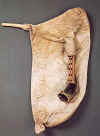 The sabouna is a Greek
bagpipe characteristic of the Cycladic musical tradition and found throughout that island
group. It is much less well known compared to other traditional wind instruments such as
the klarino (clarinet) or the gaida (the mainland bagpipe). The sabouna has existed
uninterruptedly in the Mediterranean for more than two thousand years and currently faces
extinction. Very few people still show interest in the instrument today. Sabouna musicians
live in obscurity as retired farmers or building workers, and there is almost no call for
the music from the younger generation now. The sabouna is a Greek
bagpipe characteristic of the Cycladic musical tradition and found throughout that island
group. It is much less well known compared to other traditional wind instruments such as
the klarino (clarinet) or the gaida (the mainland bagpipe). The sabouna has existed
uninterruptedly in the Mediterranean for more than two thousand years and currently faces
extinction. Very few people still show interest in the instrument today. Sabouna musicians
live in obscurity as retired farmers or building workers, and there is almost no call for
the music from the younger generation now.Why this is so is a complex issue, but the main reason is the change in general lifestyle. The sabouna is an instrument found mostly in the countryside, and made by the musician himself out of natural materials at hand. It is also an instrument that uses only six notes, which does not fit in with western scales. The specific sound it makes is unusual, even primitive, compared to the more rounded-out sounds of contemporary music. Today, the Myconos players of the sabouna and doubaki (drum), although rather elderly, continue to entertain at the panigiria (festivals), church festivals and Saints' names days. The panygiri is a tradition that is still enjoyed and cherished by the island's permanent inhabitants, and maintains a prominent place in local life. In the past, the panygiri music was exclusively that of the sabouna. Presently, there is a range of instruments, repertoire and entertainment at these social gatherings. 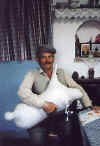 The tsabouna-or
sabouna, as it is referred to in the Myconos dialect-is a wind instrument with ancient
origins, perhaps the most ancient still in use today. The name sabouna comes from the
Italian zampogna, which is related to the Greek word symphonia. The exact provenance of
the instrument is unknown. It is mentioned in the Old Testament, the Book of Daniel, and
in Aristophanes' (446-385 BC) Lysistrata as the physatria (something blown), probably the
wind instruments with a bag. Recorded on papyrus in the Law of Arsenoitus (131-132 AD),
the asklavos (the instrument), and asklavion (the musician playing it) are referred to for
the first time as invited to play against payment at religious festivals, feast days and
ritualistic celebrations, just like almost two thousand years later. The sabouna could
also have developed without an askos (airbag), as can be seen on ancient vases showing
activities with musicians with puffed cheeks playing the avlos, an oboe-like, double reed
wind instrument which is the forerunner of today's zourna. They probably used the
technique of circular breathing, which today's zourna players still practice to produce a
continuous flow of air and, hence, sound. The invention of the bagpipe not only outmoded
this difficult technique, but also by storing air in an "external lung" it
allowed the musician to sing while playing. The tsabouna-or
sabouna, as it is referred to in the Myconos dialect-is a wind instrument with ancient
origins, perhaps the most ancient still in use today. The name sabouna comes from the
Italian zampogna, which is related to the Greek word symphonia. The exact provenance of
the instrument is unknown. It is mentioned in the Old Testament, the Book of Daniel, and
in Aristophanes' (446-385 BC) Lysistrata as the physatria (something blown), probably the
wind instruments with a bag. Recorded on papyrus in the Law of Arsenoitus (131-132 AD),
the asklavos (the instrument), and asklavion (the musician playing it) are referred to for
the first time as invited to play against payment at religious festivals, feast days and
ritualistic celebrations, just like almost two thousand years later. The sabouna could
also have developed without an askos (airbag), as can be seen on ancient vases showing
activities with musicians with puffed cheeks playing the avlos, an oboe-like, double reed
wind instrument which is the forerunner of today's zourna. They probably used the
technique of circular breathing, which today's zourna players still practice to produce a
continuous flow of air and, hence, sound. The invention of the bagpipe not only outmoded
this difficult technique, but also by storing air in an "external lung" it
allowed the musician to sing while playing.All bagpipes have the following elements in common: the mouthpiece is made from bone or wood; the askos is made from animal skin (leather); the avlos consists of a base containing one or two reeds to produce sound, one or two pipes with holes for the fingering, and finally a horn or carved piece of wood directs the sound. In terms of sound production, the single-reed pipes are the front-runners of the clarinet. Many have one or more separate pipes to produce only one tone, the iso or drone. The sabouna of the Greek islands is among the few bagpipes that do not have a separate drone, and so are of more primitive construction. That does not make it easier to play. The singular family of wind instruments exists in many forms throughout the world, but most commonly in Europe as the gaida (Northern Greece and the Balkans), cimpol (Romania), duda (Hungary), Dudelsack (Germany), sakkpiap (Sweden), bagpipe (Ireland and Scotland), zampogna (Italy), touloum (Turkey, and gaita (Spain). Greece has two types of bagpipes, the sabouna and the gaida. The gaida, which has a drone, is found in mainland Greece, mostly in Macedonia and Thrace. The sabouna belongs to the Aegean islands, the Ionian islands, the Black Sea, and the Mani (Western Peloponnese). The names used for the sabouna vary from place to place. In Naxos it is the tsabounasko, in Crete the askomathoura, in Ikaria the tsabounofilaka, in Kefalonia the askotsabouno, in Syphnos the kainta, in the Mani the moskotsabouno, and in the Black Sea area the touloum zournas. It is unknown when the sabouna and the doubaki first came to Myconos. 94-year old islander Stephanos Antoninis, who spoke of hs memories, provides the first account of the sabouna in Myconos. "When I was five years old, I would go with my mother in and out of various kazina where they were playing the sabouna and the doubaki, the zia. The kazina went on from Epiphany (January 6) to Clean Monday (first day of Lent). IN those days the sabouna was played all the time, and because there were always several sabouna players, when one got tired, another would carry on and the dancing never stopped". 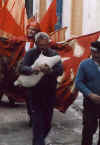 The
word zia in Mykonian dialect means, "the pair", the name given to the island's
musical groups, particular the sabouna and the doubaki. The kazina described by Antoninis
were "dances" held in ground floor parlors of houses in Myconos. The rooms were
temporarily transformed into public places for dancing. The dances that occurred between
Epiphany and Clean Monday were called ballosia. Everyone had fun at them, especially the
sailors, before they left in early spring on their long trips at sea. Those carnival
dances at the kazina were without any special amenities; the floor was made up of trampled
dirt, there were no chairs; the only refreshments served were nuts or liquor. It was the
music that was the most important element, with young people dancing and flirting. The
word zia in Mykonian dialect means, "the pair", the name given to the island's
musical groups, particular the sabouna and the doubaki. The kazina described by Antoninis
were "dances" held in ground floor parlors of houses in Myconos. The rooms were
temporarily transformed into public places for dancing. The dances that occurred between
Epiphany and Clean Monday were called ballosia. Everyone had fun at them, especially the
sailors, before they left in early spring on their long trips at sea. Those carnival
dances at the kazina were without any special amenities; the floor was made up of trampled
dirt, there were no chairs; the only refreshments served were nuts or liquor. It was the
music that was the most important element, with young people dancing and flirting.Playing the sabouna requires a special technique learned by seeing and hearing and then trying and trying again. Sabouna players do not resort to any formal instruction; their greatest motivation is the desire to play and unyielding stubbornness. Most began with the monosabouno, a single sabouna which they fashioned themselves from a piece of reed, or in combination with a plouska, a pig's bladder, tied to one end. This does not require much air, so that even a child five or six years old an easily produce the sound. The sabouna player uses the unique technique of closed fingering. This means that all the holes are kept covered, and it is when one finger is lifted from its hole that the desired note is produced - exactly the opposite of all classical wind instruments, as well as of the mainland bagpipe, the gaida. If no air is leaking from the askos bag, the sabouna player is able to sing as he is playing, something that is impossible with wind instruments that have no airbag. There is no bibliography in existence of the Myconos sabouna player's songs and music. Historical recordings are limited to one single from the 1960s, produced by the untiring Domna Samiou. The Ballaristos, Sousta and the wedding dance Ballos are deeply rooted rhythms of the various instrumental and vocal melodies of the island. In addition many other mainland (Kitso's Mother, The Souliotisses) and island folk songs and popular hits of today have become Myconian, by being transformed through the medium of the sabouna as played by musicians able to express the joys and sufferings they have experienced in their own lives. |
| Music Traditions from
the Dodecanese Islands |
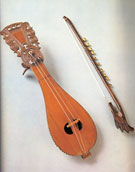 The music tradition of the Dodecanese islands is among the richest in
Greece. It was a tradition born on the islands themselves, through the particular way of
life and challenges of the inhabitants. However, we should note there are certain
qualities inherent in this music which was determined by the region or segment of the
population; for example, the musical elements were affected by the presence of notable
musicians, teachers, etc. in the region who influenced the course of music in that
particular area). Therefore, it is not uncommon for many quite different songs to be
present in neighboring villages on one small island. The music tradition of the Dodecanese islands is among the richest in
Greece. It was a tradition born on the islands themselves, through the particular way of
life and challenges of the inhabitants. However, we should note there are certain
qualities inherent in this music which was determined by the region or segment of the
population; for example, the musical elements were affected by the presence of notable
musicians, teachers, etc. in the region who influenced the course of music in that
particular area). Therefore, it is not uncommon for many quite different songs to be
present in neighboring villages on one small island.The basic musical instruments on all the islands were the lyre, the "tsabouna" (type of bagpipe) and the lute. The Dodecanese lyre was small, like that of Constantinople, and had three or, very rarely, four strings. But today it has almost disappeared from most of the islands and is found only in Karpathos, Kassos and Chalki. One reason for this is the influence of Asia Minor on the islands. The songs of Smyrna had already started to spread long before the Asia Minor disaster of 1922, (either through sailors traveling more often to nearby Smyrna than to Piraeus) or through teachers, church-chanters and intellectuals moving from Smyrna and Constantinople to work in the islands. There were several cases where enlightened music teachers organized the music of the islands with the help of the refugees from the Asia Minor disaster. Gradually, a new musical style was created and Asia Minor songs were adapted to the island measures and became part of the various traditional rituals (weddings, saints' feasts, etc.). Some famous musicians traveled from island to island, carrying this new style of music with them, so we see the same songs were popular in different islands at the same time. Another factor determined by the Asia Minor influence was the gradual emergence of the violin as a major instrument at the expense of the traditional Dodecanese lyre. The lute became an instrument for accompaniment, while a new instrument called the dulcimer (santouri) was added to the Dodecanese band, soon becoming popular and finding favor with the virtuosos. Musicians took advantage of the violin's wider range and added new music phrases to the old dances, and also composed new ones or "imported" them from the nearby Asia Minor coast. Crete was an opposite pole of influence for some of the islands (Kassos, Karpathos). Finally, although musicians included in their repertoires tunes from Amorgos, Naxos, Ikaria and the Mainland for weddings and other events etc., these songs did not influence the local style and were danced as "foreign" dances, for the sake of variety, as were some Western European dances. 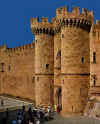 The island of Rhodes today is the focal point of the Dodecanese islands since it has
fairly large communities of people from all the other islands, as people go there to work
and study. Rhodes, owing to its size and population, but mainly due to the variety of its
inhabitants, presents a complex music profile. It is privileged to be the home of dozens
of experienced musicians who play not only Rhoditic but also songs from the other islands. The island of Rhodes today is the focal point of the Dodecanese islands since it has
fairly large communities of people from all the other islands, as people go there to work
and study. Rhodes, owing to its size and population, but mainly due to the variety of its
inhabitants, presents a complex music profile. It is privileged to be the home of dozens
of experienced musicians who play not only Rhoditic but also songs from the other islands.The dances are the usual Dodecanese dances, but in some villages they present differences in the music and name. So in Embona the "Kritikos" (Cretan) is danced (a similar dance in other regions is called "Pidihtos' (jumping) of Rhodes), and the "Boniatiki Sousta", during which the singers weave "mantinades" (rhyming couplets). In Rhodes the "Sousta" is dominant, danced in a special way so as to form a "snail", and opening out again in a semi-circle. After weddings they used to dance the "Digenis" in which the lead dancer would perform with weapons and helmet. Other popular dances include the "Kato" dance, the "Sperveri", the "Vlacha", the "Zervodexos (left and right), the "Makelari" (Hasapikos), the "Vatani", Tjenevetos, "Tseli", "Rinaki' etc. In Tilos we find two local dances, the "Maroudi", where the women sing while dancing in two rows, and the "Kamares" (arches) where the couples pass under the "arch" formed by the last couple. They also dance the common Dodecanese dances and the local Sousta. In Symi we have a dance, the "Komenos", which is in fact a suite of three dances, the "syrtos" the "ballos", and the "pou'se - na'me (where are you - here I am), which got its name from the men's question and the girls' answer. This last is often confused with the "sousta", but the Symian Sousta is a different dance, very popular throughout Greece. Other Symian dances are the "Zervodexos", "Zeibekikos", "Politikos"(syrtos) etc. In Nisyros we have local dances, like the dance of "Koupa" (cup), also found in Kos, where the lead dancer holds a cup; the dance of the "Kalesmatou" (invitation), in which young men and women, one Sunday before the wedding, go around the house of friends and invite them in this original manner to the wedding; and the "Perioli", with steps similar to the "Issos", which is danced on the second day of the wedding. In Chalki we can see a connection with Kassos and S. Karpathos. They dance the "Pano Horos", "Zervodexos", "Vlacha", "Issos", "Syrtos" and the "Chalkitiki Sousta", which has its own distinctive style. Among the instruments of Chalki, the Lyre is still dominant. 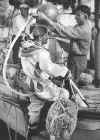 In Kalymnos, dozens of Akritic songs and paralogues, narrative verses and long love
ballads have been documented. An especially typical theme to which the couplets of
Kalymnos refer is sponge-diving, that dangerous but common profession men were obliged to
follow since the resources of the island were limited. Many of the divers who were
paralysed, and the islands society, trying to sympathize, created a local dance, the
"Mihanikos", in which the leading dancer imitates the movements of a paralyzed
diver. The main dances of Kalymnos are the "Issos' and the 'Sousta". Other
dances include the "Syrtos", the "Kalamatianos" (Argitikos, Loulouka,
Thymariotikos), the "Zervodexos" etc.
In Kalymnos, dozens of Akritic songs and paralogues, narrative verses and long love
ballads have been documented. An especially typical theme to which the couplets of
Kalymnos refer is sponge-diving, that dangerous but common profession men were obliged to
follow since the resources of the island were limited. Many of the divers who were
paralysed, and the islands society, trying to sympathize, created a local dance, the
"Mihanikos", in which the leading dancer imitates the movements of a paralyzed
diver. The main dances of Kalymnos are the "Issos' and the 'Sousta". Other
dances include the "Syrtos", the "Kalamatianos" (Argitikos, Loulouka,
Thymariotikos), the "Zervodexos" etc.Astypalea like Nisyros, has highly developed (or commonly called "group" singing), i.e. at feasts, one person sings the introductory exclamation and the first half-line of a couplet, which is repeated by the rest. The dances of Patmos are the usual Dodecanese dances. We also have the "Kollitos", and two dances dating from Byzantium, the "Ballaristos"and the "Langeftos". The men also danced the "Hasapiko" and "Arvanitiko". Kos presents at least four "music zones". In the first are the urban-style songs of the capital, in which the influence of Asia Minor finds its best expression. At the other end of the island is Kephalos, where the influence of Cretan music is prevalent. At the heart of the island is Antimachea, which has preserved its remnants from old virtuosos who had worked several variations into the basic melody. And finally, there are the Asphentiou region and Pyli, which retain some of their special style, though they have lost their great heritage of ballads. Today the islanders sing only the usual tunes to which couplets are adapted. Leros, like the rest of the Dodecanese islands, is known for beautiful songs depicting the wedding ("pastika"). The dances are the "Lerikos" (type of "Issios" dance), the Syrtos, the Zervos, the "Ballaristos", the "Sousta", as well as the dances of neighborhood islands, the "Kotikos", the 'Pidihtos", the "Gaitani" etc. Karpathos, with its elongated shape, presents two musical idioms, one in the North and one in the South. In the North, mainly at Olympos and Diaphani, the basic instruments are the lyre (its bow has about ten small bells which emphasize the rhythm), the "tsabouna" (a type of bagpipe) and the lute, a more recent instrument.  One could maintain that in all Greek-speaking lands there is no other region that has
retained its musical tradition to such a degree. Hundreds of songs many centuries old are
sung on all occasions by the whole village. One could imagine that the "Akrites"
still live and inspire the popular muse with their daring deeds.
One could maintain that in all Greek-speaking lands there is no other region that has
retained its musical tradition to such a degree. Hundreds of songs many centuries old are
sung on all occasions by the whole village. One could imagine that the "Akrites"
still live and inspire the popular muse with their daring deeds. The dances of Northern Karpathos are the "Syrmatic", the "Siganos" (slow), the 'High Dance" (fast, spirited), the "Zevos" (left), the 'Gonatistos", the 'Sousta", the "Kephalonitika" etc. In Southern Karpathos we now find only the violin and the lute, though in some villages they also play the "tsabouna". In some cases the Cretan lyre has replaced the small pear-shaped Karpathian lyre. |
Last revised:
12/27/2011 08:27 AM